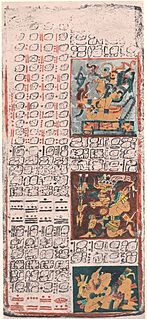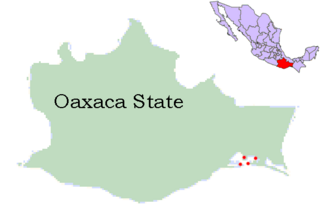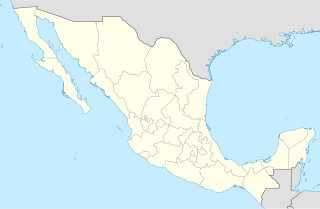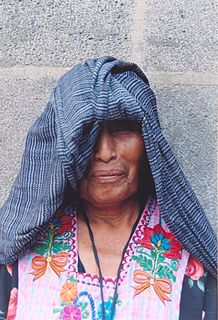See also
| This disambiguation page lists articles associated with the title Huave. If an internal link led you here, you may wish to change the link to point directly to the intended article. |
Huave may refer to:
| This disambiguation page lists articles associated with the title Huave. If an internal link led you here, you may wish to change the link to point directly to the intended article. |

Indigenous languages of the Americas are spoken by indigenous peoples from Alaska, Nunavut, and Greenland to the southern tip of South America, encompassing the land masses that constitute the Americas. These indigenous languages consist of dozens of distinct language families, as well as many language isolates and unclassified languages.

Penutian is a proposed grouping of language families that includes many Native American languages of western North America, predominantly spoken at one time in British Columbia, Washington, Oregon, and California. The existence of a Penutian stock or phylum has been the subject of debate among specialists. Even the unity of some of its component families has been disputed. Some of the problems in the comparative study of languages within the phylum are the result of their early extinction and limited documentation.
WABI or wabi may refer to:

Mesoamerican languages are the languages indigenous to the Mesoamerican cultural area, which covers southern Mexico, all of Guatemala and Belize and parts of Honduras and El Salvador and Nicaragua. The area is characterized by extensive linguistic diversity containing several hundred different languages and seven major language families. Mesoamerica is also an area of high linguistic diffusion in that long-term interaction among speakers of different languages through several millennia has resulted in the convergence of certain linguistic traits across disparate language families. The Mesoamerican sprachbund is commonly referred to as the Mesoamerican Linguistic Area.

Oto-Manguean or Otomanguean languages are a large family comprising several subfamilies of indigenous languages of the Americas. All of the Oto-Manguean languages that are now spoken are indigenous to Mexico, but the Manguean branch of the family, which is now extinct, was spoken as far south as Nicaragua and Costa Rica. Oto-Manguean is widely viewed as a proven language family. However, this status has been recently challenged.

This article is a list of different language classification proposals developed for indigenous languages of the Americas. The article is divided into North, Central, and South America sections; however, the classifications do not always neatly correspond to these continent divisions.
HVV is the public transport body in Hamburg, Germany Hamburger Verkehrsverbund.

Many different languages are spoken in Mexico, though Spanish is the most widespread. The indigenous languages are from eleven distinct language families, including four isolates and one that immigrated from the United States. The Mexican government recognizes 68 national languages, 63 of which are indigenous, including around 350 dialects of those languages. The large majority of the population is monolingual in Spanish. Some immigrant and indigenous populations are bilingual, while some indigenous people are monolingual in their languages. Mexican Sign Language is spoken by much of the deaf population, and there are one or two indigenous sign languages as well.
Hue is the gradation of color.
Huave is a language isolate spoken by the indigenous Huave people on the Pacific coast of the Mexican state of Oaxaca. The language is spoken in four villages on the Isthmus of Tehuantepec, in the southeast of the state, by around 18,000 people.

The Huave are an indigenous people of Mexico. The autodenomination term used by the Huave themselves is Ikoots or Kunajts, or Mareños. They have inhabited the Isthmus of Tehuantepec for more than 3000 years, preceding the Zapotec people in settling the area. Today they inhabit several villages on the sandspits of the Pacific Ocean and trade marine products with inland neighbors. According to the 2000 census, 13,687 people declared themselves to be Huave speakers, however, many non-speakers still identify as Huaves or Mareños. Their language is called Huave, or ombeayiüts/umbeyajts, depending on the dialect.
Macro-Mayan is a proposal linking the clearly established Mayan family with neighboring families that show similarities to Mayan. The term was apparently coined by McQuown (1942), but suggestions for historical relationships relevant to this hypothesis can be traced back to the Squier (1861), who offered comparisons between Mayan and Mixe-Zoquean languages, and Radin, who did the same for Mixe-Zoquean, Huave, and Mayan.

San Dionisio del Mar is a town and municipality in Oaxaca in south-western Mexico. It is part of the Juchitán District in the east of the Istmo de Tehuantepec region. The town is named after its patron saint.

San Francisco del Mar is a town and municipality in Oaxaca in south-western Mexico. It is part of the Juchitán District in the west of the Istmo de Tehuantepec region.

San Mateo del Mar is a coastal town and municipality in Oaxaca in south-western Mexico. It is part of the Tehuantepec District in the west of the Istmo Region. It is the largest of four Huave towns in the region, the others being San Dionisio del Mar, San Francisco del Mar and Santa María del Mar.

The Indigenous people of Oaxaca are descendants of the inhabitants of what is now the state of Oaxaca, Mexico who were present before the Spanish invasion. Several cultures flourished in the ancient region of Oaxaca from as far back as 2000 BC, of whom the Zapotecs and Mixtecs were perhaps the most advanced, with complex social organization and sophisticated arts.

The state of Oaxaca, Mexico has a total population of about 3.5 million, with women outnumbering men by 150,000 and about 60% of the population under the age of 30. It is ranked tenth in population in the country. Fifty three percent of the population lives in rural areas. Most of the state’s population growth took place between 1980 and 1990. Life expectancy is 71.7 for men and 77.4 for women, just under the national average. Births far outpace deaths. In 2007, there were 122,579 birth and 19,439 deaths. Approximately 85% profess the Catholic faith.
HUV may refer to:
The Ostana Prize – Writings in the Mother Tongue [in Italian: Ostana Premio Scritture in Lingua Madre], is an annual prize and cultural initiative organized by the Municipality of Ostana and by the Cultural Association Chambra d'Oc. It is dedicated to languages and to literary authors who use a "mother tongue", a present-day minority language of territorial belonging, in their works. The event began in 2008 and is held in Ostana, a municipality in the Valle Po (Italy), every year at the beginning of June. It is open to the public with free admission.